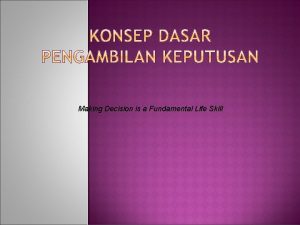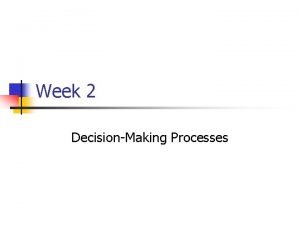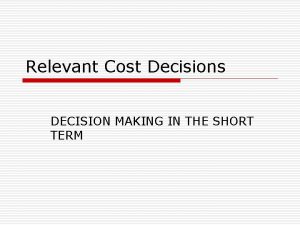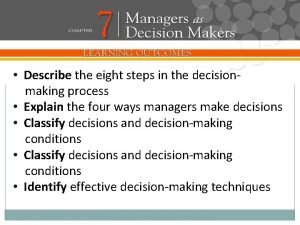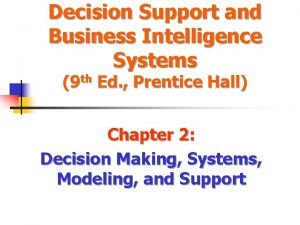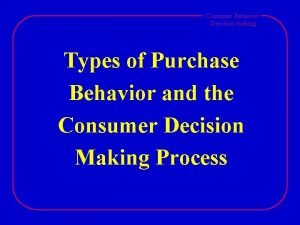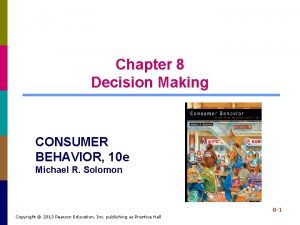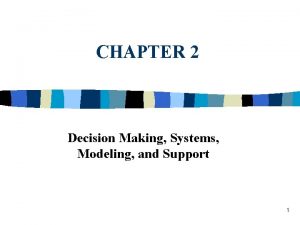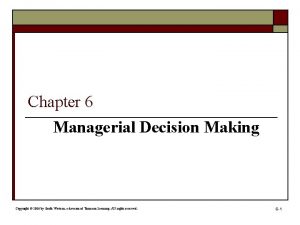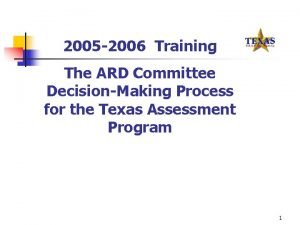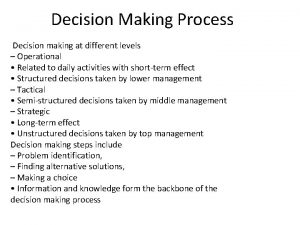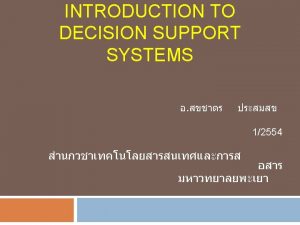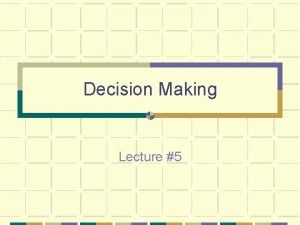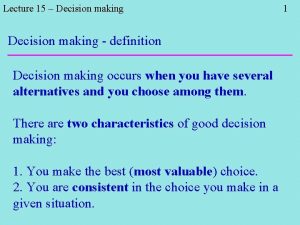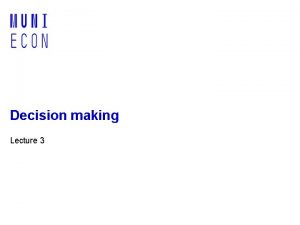Lecture 6 Decision Making The Decision Process Fundamental



















- Slides: 19

Lecture 6 Decision Making

The Decision Process • Fundamental Process of Management Involves 6 Steps: – Specify Objectives and the Criteria for decision making – Develop Alternatives – Analyze and compare alternatives. – Select the best alternative. – Implement the chosen Alternative – Monitor the results to ensure the desired results are achieved.

Decision Environments • There are three scenarios which refer to Certainty, Risk and Uncertainty: – Certainty: Profit per unit is Rs. 50. You have an order for 2000 units. – Risk ( There is a 25 % chance of 2000 units, 50% chance of 1000 units and 25 % chance of an order of 500 units). – Uncertainty ( There is no available data of demand forecasts) means that the certain parameters necessary for decision making are absent.

DECISION THEORY • Decision theory consists of the following three elements. 1. A set of possible outcomes exist that will have a bearing on the results of the decision. 2. A list of alternatives to choose from. 3. A known payoff for each alternative under each possible future condition.

DECISION THEORY • An operations manager needs to employ the following: 1. 2. 3. 4. 5. Identify a set of possible future conditions called state of nature Develop a list of alternatives, one of which may be to do nothing. Determine or estimate the payoff associated with each alternative for every possible future condition. If possible estimate the likely hood of each possible future condition. Evaluate alternatives according to some decision criterion ( e. g. maximize expected profit) and select the best alternatives to choose from.

PAY OFF TABLE • Payoff table summarizes, the information of a decision and captures the expected payoffs under various possible states of nature. • Lets take an example, we are setting up a pharmaceutical factory and our state of nature indicates that If we built a small facility the return remains the same whether the demand is low or high, the medium facility indicates a constant return on moderate and high. If we build a large facility chances are that the return would only be good if we have a high demand or return.

PAY OFF TABLE Alternatives Possible Future Demands Low Small Facility Medium Large Moderate High Rs. 10 M Rs. 5 M Rs. 1 M Rs. 8 M Rs. 2 M Rs. 15 M

Techniques for Decision Making under Uncertainty • • Maximin Maximax Minimax Regret Laplace

Decision Making under Uncertainty • Maximin determines the worst payoff for each alternative. • The operations manager chooses the best worst alternative. Meaning the least (best) of the worst. • It is a pessimistic approach. • Ensures a guaranteed minimum.

Decision Making under Uncertainty • Maximax determines the best possible outcome. • It chooses the Alternative with the best possible payoff.

Decision Making under Uncertainty • Laplace determines the Average payoff for each alternative. • It chooses the alternative with the best average.

Decision Making under Uncertainty • Minimax Regret determines the worst regret for each alternative. • Chooses the alternative with the best worst. • This approach seeks to minimize the difference between payoff that is realized and best payoff for each state of nature.

Example to calculate Minimax Regret • Minimax Regret: • Step I ; Construct the Table of Opportunity Losses or Regrets. • Step II. Select the maximum regret value of each value.

Decision Making under Risk • The area between the certainty and uncertainty is known as Risk. • EXPECTED MONETARY VALUE CRITERION which refers to the best expected value among the alternatives • We use the payoff table with probabilities low =0. 3, moderate =0. 5 and highest=0. 2. These probabilities must add to 1, mutually exclusive and collectively exhaustive)

Expected Value of Perfect Information • Expected value of perfect information = Expected payoff under certainty -Expected payoff under risk

Decision Trees • A schematic representation of the alternatives and their possible consequences. • The diagram resembles a tree. • Extremely suitable for analyzing and evaluating situations which involve sequential decisions.

Decision Trees • Initially the government had an information that it can exploit 1 million cubic feet of gas but later studies indicate potential reserves of additional 10 million cubic feet. • As an operations manager you may be ask to prepare a feasibility report to either expand or make a new facility using the new reserves.

Decision Trees Low Demand = 0. 4 Rs. 20 Build small High Demand = 0. 6 Do Nothing Rs. 20 Reduce capacity - Rs 30 Expand = Rs 50 Do Nothing = Rs. 15 Low Demand=0. 4 Build Large High Demand= 0. 6 Rs. 60/unit Reduce Prices Rs. 45

Decision Trees • Step I. Analyze the decisions from Right to left • Step II. Determine which alternative would be selected for each possible second decision. • Step III. Repeat the steps for both low and demand pattern for the larger facility. • Step IV. Determine the product of chance probabilities • Step V. Determine the expected value of each initial alternative. • Step VI. Select the choice which has a larger expected value than the small facility.
 Making decision is a fundamental life skill
Making decision is a fundamental life skill Tabel proses smart choice(s)
Tabel proses smart choice(s) Tabel proses smart choice(s)
Tabel proses smart choice(s) No decision snap decision responsible decision
No decision snap decision responsible decision Financial decision
Financial decision Systematic decision making process
Systematic decision making process Steps in decision making
Steps in decision making Consumer decision making process
Consumer decision making process Chapter 11 decision making and relevant information
Chapter 11 decision making and relevant information Eight steps in decision making
Eight steps in decision making Systematic decision making process
Systematic decision making process Divestment in consumer decision process
Divestment in consumer decision process Decision making process consumer behavior
Decision making process consumer behavior Decision chapter 8
Decision chapter 8 Systematic decision making process
Systematic decision making process Systematic decision making process
Systematic decision making process Scope of decision making
Scope of decision making 6 step decision making process
6 step decision making process Chapter 3 financial decision making
Chapter 3 financial decision making Ard committee decision making process
Ard committee decision making process

